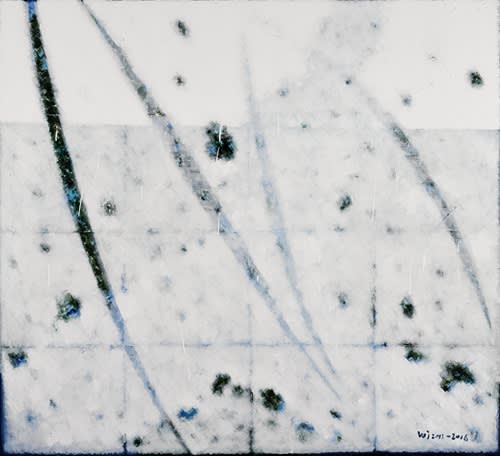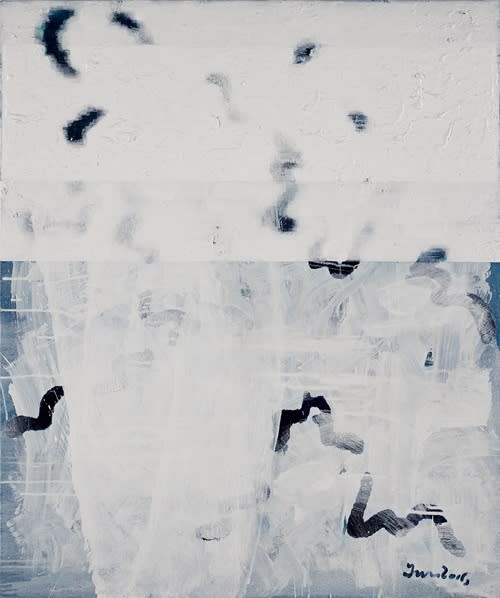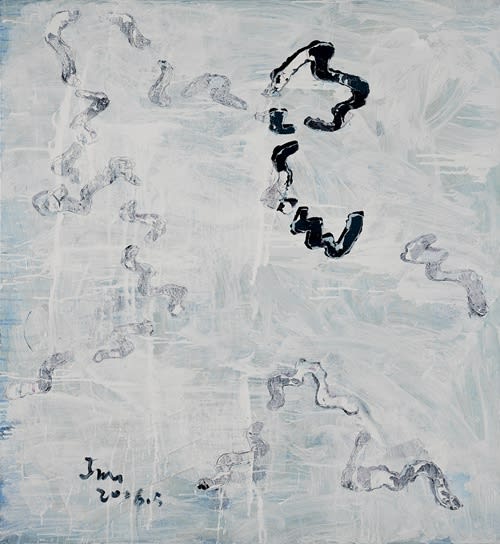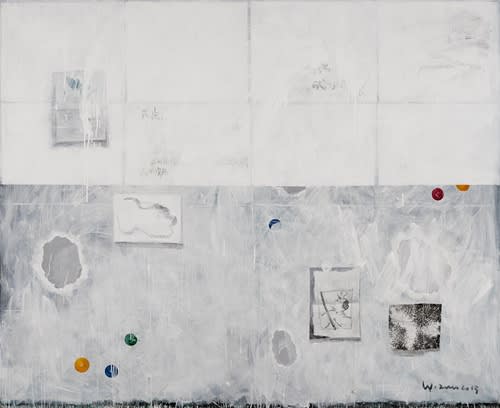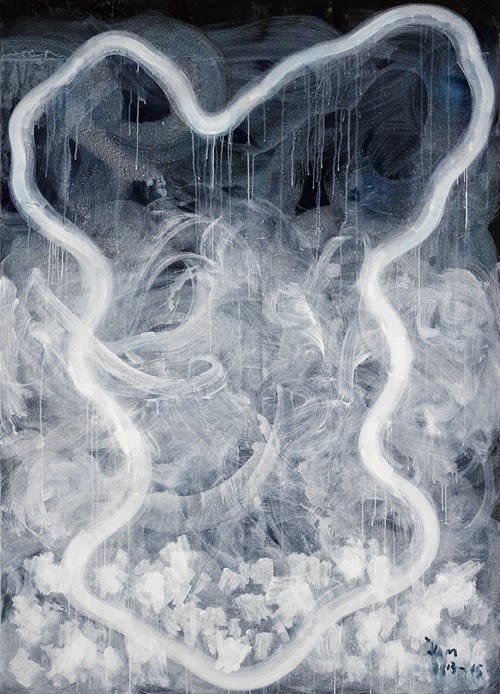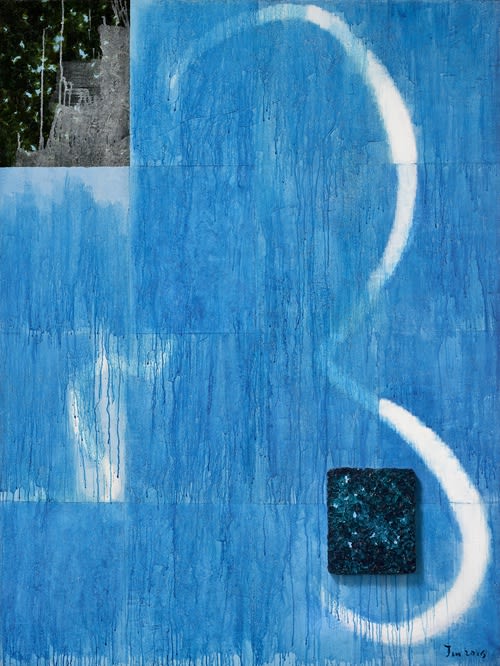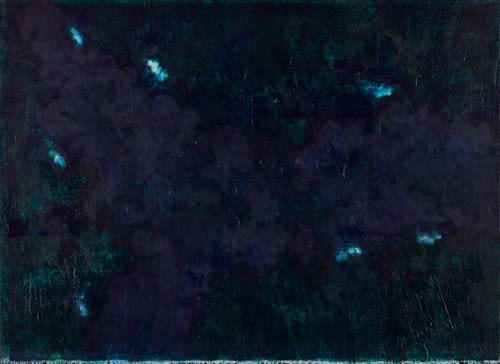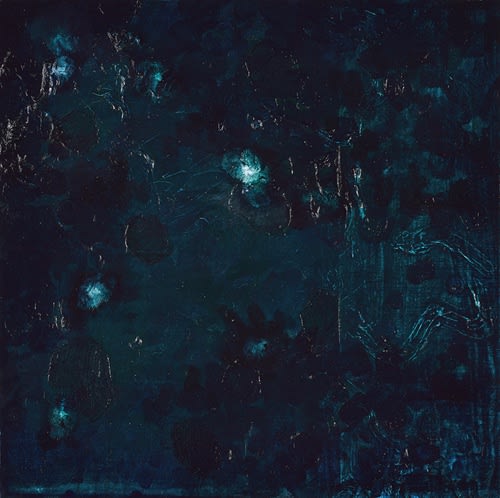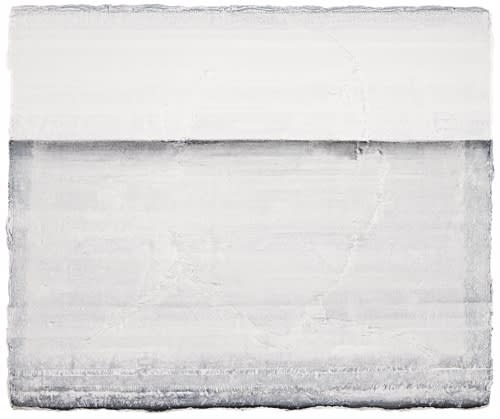Flashback: Wang Jun Solo Exhibition
观看的拓扑——王俊的“元绘画”实验
鲁明军
诚如王俊在笔记中反复提及的,对他而言,绘画背后的意义不是目的,他所探问的只是绘画本身,或者说,这是一种关于绘画的绘画,即一种“元绘画”。于此,我们似乎可以追溯至格林伯格(Clement Greenberg)的论述。格氏说过,前卫艺术是关于绘画的绘画,与之相对的庸俗艺术则是关于某个具体所指或意义的绘画。前者关乎的是绘画过程本身,而后者则意在绘画的结果。格氏的目的是将绘画还给绘画本身,王俊亦复如此。他们共同感兴趣的是绘画媒材,是画布、画架及颜料的特性,等等。我想,这样一种对绘画本身的体认自然地构成了讨论王俊绘画的一个基本前提。
自不待言,格林伯格力主回到绘画本身背后存有一个反思和批判的语境,但对于王俊来说,即便客观存有一个亟待反思和检讨的对象,也无关他的绘画本身。至少可以表明的是,他的绘画并非源自这一客观目标,而更多是自我实验和游戏本身。因此,我们无须为它后置一个整体性的时空场域。
尽管诸如抽象、具象这样的艺术史概念已经无法——亦无必要——概括和界定许多当代作品,但讨论王俊的绘画,我还是不得不援引这对语词。并不是说我要对王俊绘画进行这样的分类和定位,只是将其作为一种话语载体(或只是作为一种说法),以便进入其画面本身及其内在的层次结构。
显然,在王俊的绘画中,我们既看不到任何宏大叙事的痕迹,也看不到任何微观政治的影子,只有色彩、笔触,以及并无任何意义指涉的图像(或图式)——尽管任何图像都不可避免地有所指涉。我不知道在早期绘画中,王俊是怎么处理色彩关系的,但在近几年的作品中,他似乎一直痴迷于黑、白、灰的有机调配。这种色彩的纯化不仅形成了一种虚幻的视错觉,也赋予了画面一种与众不同、甚至有悖于自然的光影感,从而凸显了画面及其物象所本有的立面感。不过,这并不是指某个具体物象(或整体性物象)的特性,而是许多小笔触所构成的可移变的平面化拓扑。我们发现,王俊在处理这些小笔触的时候,并没有做太多的变化,多采用均质化的方式平面地展开铺排,或通过一种平均分割的方式将某一具体物象解构为碎片。或许,笔触或线条所具有的密度与厚度与他早年的版画创作经验有关(包括龚贤积墨的影响),但这种类似抽象的效果(但实际上不是抽象)显然又消弭了画面原本所具有的立面感。
于是,画面不仅在色彩上构成了一种视错觉,而且,在形式处理(抽象/具象)中,也生成了一种不乏张力的视错觉。双重的视错觉最终是为了实验和探索一种观看的可能。王俊认为,这就是绘画本身。如果说绘画有本质的话,那么王俊认定就是“观看的呈现”。不过,这一“观看的呈现”并非建立一个固有的通道或入口,相反,更多的时候,这恰恰成了一种观看的迷障。按王俊自己的说法,实际上这是一种“象”的幻觉,一种“感觉的幻觉”,或一种“视觉言说的谎言”。因此,“观看的呈现”本质上是一种视域的开启和拓展,而不是规约或限定。
尽管如此,我想对于大多绘画者而言,制造一种视错觉实际上并不是什么难事。王俊自然晓得此理。因此,他的“元绘画”实验在某种意义上恰恰是要超越作为绘画结果的视错觉,在过程中诉诸观看方式的尝试和探问。
明眼者并不难发现,王俊的小笔触(线和点)更像是“做”出来的,而不是“画”出来的。事实也的确如此,或许因为太过细微,笔触和颜料所具有的绘画性及其质感反而被弱化或消解。对此,王俊不是没有意识。他在四周或某边通过大笔触和肌理“破坏”了画面原本所具有的均质感或平面性,有时候,我们发现这样一种处理方式显得极不协调,貌似一幅未完成或被破坏了的画面。然而,在王俊看来,画面完整性的“破坏”恰恰标明了这就是绘画本身。太过完整的画面所提供的往往不是绘画本身,而是绘画背后或绘画以外的讯息,完整性的阙如反而使得绘画更接近绘画本身。特别是近作中显得更为大胆,在坚持琐碎的描摹和铺排的同时,他开始尝试一种放肆但又不乏节制的表现性书写。在此我们已很难看到某个具象的存在,画面的结果也不纯然是抽象的样式。譬如他通过在画面上(或画面旁边)拼置与之相应的手稿,从而打破了原本的平面性和抽象感,而更像是在建构一种空间关系,整个画面也因此变得更为丰富和不确定。说到底,他的实验和游戏是在尝试观看的维度上(准确地说是没有维度的维度)绘画到底有多少可能。
如果说绘画是一个编织谎言的过程的话,那么,王俊念兹在兹的正是这个编织过程本身,而不是作为结果的谎言。所以,他的绘画实验所针对的也正是整个过程。在近作中,他通过图像考古学的方式,对于绘画本身进行了逐层剥离和析解。但是,王俊并没有丢弃他所剥离开来的每一个层次(包括元图像、对元图像进行持续临摹所刻意产生的图像、临摹过程中随意留下的笔触),而是对这些层次进行了拼置、叠加和重组,进而形成了一个极具质感的“平面”。王俊将其界定为“一种不乏观看障碍的临界状态”。与之相应,所谓的“观看的拓扑”,意即无论怎么改变画面形式、大小、语言风格、图像内容、色彩关系,包括背后的意义,等等,但对于王俊而言,如何不断地开启绘画本身所可能具有的属性和特质才是他真正的诉求所在。反过来,这一开启只有在这样一种临界状才具有实现的可能。而“观看的拓扑”也是在这一临界状展开的。
或许这样一种方式即是他所谓的“物”的方式。在这里,“物”是“空”,是“无”,“它”不能为任何别的东西所代表,或者更确切地说,它只能为别的某个东西所代表”。所以,所谓“空”、“无”,不是什么也没有,而是什么也不是,正是因为其不是什么,所以它永远“是”一种可能性。近来这种类似日课的方式恰恰体现了作为一种工作的绘画实践,实际上是为了将自我(或主体意识)从中抽离出去。在他看来,“只有将作者自身抛出去”,才能将物还给物,才能将绘画还给绘画。换言之,王俊是为了将绘画从意义或既有认知的支配和宰制中解放出来。他说:“消解意义是对意义的困惑,困惑是靠近真的前提”,“只有放弃明确,才能肯定不确定”。而“不确定(即延异的,闪烁的,潜隐的)无疑更接近真实”。
至此,我想有必要说明的一点是,王俊绘画中的密度感表面上具有强烈的时间体验,但对于他而言,时间的内在展开并不重要,他更在乎的是绘画过程的展开方式,而不是展开的尺度、力度及其可能所具有的(意义)深度。
拉康(Jacques Lacan)曾经说过,社会功能明显的(写实)绘画大多都是为特定观众看的,但对塞尚而言,重要的是画笔运动下的“一点点蓝色、一点点白色、一点点棕色”,即画布上那些“小小的肮脏沉淀物”(small dirty deposits)。这是画家自己遗留的痕迹,是一个看来不经意的替代物,同样也是被精力贯注而交换欲望的对象物。因此,绘画者总是以自身的一部分作为作品的材料,但是此部分在画布上或词语中却已经转化,而不再被辨识。
在这里,拉康实际上赋予了绘画一种生命感。他明确地告诉我们,绘画是画家遗留的痕迹,是贯注精力而交换欲望的对象物。因此,尽管我们看不见,也不可辨识,但我们不能否认画面中还是有着属于绘画者自身的一部分。所以,画面虽已成为其它的物质形态,但我们不能忽视形成这一物质形态的能量本身。不同的是,在王俊这里,这种能量则被转化得更为彻底,以至于我们根本看不到丝毫欲望和身体的痕迹,所有的内在推力都变得更为隐深。我想,在这个意义上,王俊的拓扑实验无疑已然迥异于——甚至超越了——塞尚等早期现代主义绘画。
The Topos of Beholding
Wang Jun’s "Meta-painting" Experiment
Lu Mingjun
As Wang Jun has repeatedly emphasized in his notes, what interests him is not the meaning that underlies a painting, but painting itself. In other words, his work is "meta-painting," or painting about painting. According to Clement Greenberg, the painting of the Avant-garde concerns painting in its signification while Kitsch operates within the realm of the signified. In this sense, the former is interested in the process while the latter result. Both Greenberg and Wang Jun want to advocate a return of painting to itself through its medium, such as the canvas, the easel and the qualities of the paint etc. I believe Wang's own understanding of the subject matter should serve as a foundational premise of any discussion about his work.
It is understood that Greenberg's call to return to painting itself has originated from a reflective and critical context, yet for Wang Jun, his work is unhindered by the existence of an unexamined object; what can be elucidated is that his work is more engaged in self-experiment and play rather than the pursuit of objectivity. Therefore, we do not need to place it within a totalizing time-space field.
Though concepts like "abstract" and "figurative" can no longer define or delimit many works of contemporary art, I nevertheless need to resort to them when discussing Wang Jun's work. Not that I intend to classify and position his work through the employment of these terms, but simply using them as vessels of discourse (or ways of talking about it) in approaching the paintings themselves and their internal stratifications.
There is no vestige of the grand narrative or micro-politics in Wang's work, only color, brushwork, and the image (schema)—though all images are caught in the process of referral by default. To a certain extent, I'm not entirely familiar with how Wang treated color relations during his early phase, but in his recent works he seemed to be preoccupied with the organic organization of black, white and grey. This distillation not only created a visual illusion, but also bestowed a unique, almost unnatural lighting to his work, thus setting in relief the sense of the façade intrinsic to the image. Yet, this facade is not a quality of a specific image (or of images as a whole), but the mobile planar topology constituted by the meticulous brushwork. We can see that Wang has kept variations to a minimum in his execution, thus manifesting an expansion of a flat surface in a homogeneous manner or a deconstruction of a specific image into fragments through an equalizing division. Perhaps the density and thickness of the brush work or lines are related to his earlier encounter with etching [including the influence from Gong Xian and his 积墨 (Ji Mo) technique], but these effects that resemble abstraction (which in fact are not abstractions) have also erased the façade of the painting.
In this sense, the illusion is not only achieved through color, but also in terms of formal construction (abstract/figurative). Through this dual-illusion, a unique investigation of the possibility of beholding is set in motion. Wang believes this twofold construction along with its specific orientation ultimately constitute what painting is in itself. If painting has an essence, then Wang would posit that it is the "making-appear of beholding." Yet, this making-appear does not point to a pre-established channel or entrance, on the contrary, it constitutes the very obstruction of beholding. In Wang's own words, this manifesting is an illusion of the "Xiang" (象),a "perceptual dissimulation," or a "visual utterance of a lie." Therefore, the "making-appear of beholding" is in essence an enopening exploration of the horizon rather than its regulation or limitation.
Even so, Wang Jun certainly recognizes the fact that it is not difficult for most painters to construct a visual illusion. Therefore his "meta-painting"gears toward precisely the transcendence of illusion inherent in the way painting appears and the experimentation and questioning within different modes of beholding.
To the perceptive observer, Wang Jun's meticulous brush- work (lines and dots) appear "produced" rather than "painted." This is true, the brush work has been rendered in such punctilious manner to the extent of enervating even dissolving the painterliness (malerisch) of the brush work itself. Wang Jun is certainly aware of this fact since we see him deliberately "disrupting" the homogeneity or planarity of the image by the juxtaposition of forceful brushwork and texturing. This effected discordance makes the painting resemble an unfinished or damaged image. Yet to Wang Jun, the "disruption" of a painting's completeness precisely marks what painting is in itself. What finished works furnish us with is usually not painting itself but information or meaning that lies beyond it, the lack of completion makes the painting closer to itself. Recently we began to see even more daring attempts in Wang Jun's work, while maintaining the fragmented layering approach, he began to experiment with a way of expression that is both lavish yet controlled. We no longer perceive the existence of a specific figure or the pure abstraction that characterized some of his earlier attempts. For instance, the original abstract and planar qualities are subverted by the juxtaposition of the "finished" work with its preparatory sketch, thus with a growing sense of diversity and uncertainty a spatial construction comes to view. Ultimately, his experimentation and play can be considered as an investigation into the condition under which painting is made possible within the dimension of beholding (a dimension-less dimension to be exact).
If painting can be compared to the construction of a lie, then what fascinates Wang Jun the most is precisely this process of articulation rather than the lie as a finished result. In the series "Studies of Imitation," he employed methods of archeology in the gradual extrication and explication of painting without discarding any strata that is revealed during the process; rather, through assemblage, overlapping, and reconfiguration, a "plane" rich in textual details was constructed. Wang called it "a critical state in which beholding is obstructed." The "topos of beholding" is an investigation into the way in which painting is unlocked in its essence despite variations of form, size, linguistic style, image content, color relation, meaning etc. Similarly, the possibility of opening can only be realized in the critical state from which such topological undertaking unfolds.
Maybe this is what he means by the way of the "thing." Here the thing is the "void," the "nothing," "it" cannot be represented by other things, or more precisely, it can only represented by otherness itself. Therefore, what terms like "void" and "nothing" designate are not non-existence, but the "not" of the what is. Precisely due to this "not," "it" is only what it is as a possibility. This almost liturgical methodology communicates a practice that intends to extract the self (or subjective consciousness) from the painting. To Wang Jun, one must "cast out the artist" in order to return the thing to itself, or to restitute painting. In other words, Wang wants to liberate painting from meaning or preconceptions that dominate its creation and interpretation. He says: "to dissolve meaning indicates a confusion within it, yet confusion is presupposed on the way to truth," "discarding lucidity affirms the uncertain." Yet the "uncertain (concealed, elusive and différance) are closer to truth."
At this point I want to clarify that though an intense temporal experience is conveyed through the dense surface of Wang's work, the internal unfolding of time does not in fact occupy a preeminent position in his approach. What interests him is the manner in which the process of painting unfolds rather than the consequent denomintation of the extent, strength and possible depth (of meaning) of the work.
Wang Jun’s solo exhibition “Flashback” will be opened on June 25th at A Thousand Plateaus Art Space. Wang Jun is an excellent painting explorer among young generation artists. During the past years, he keeps doing adventuresome experiments on visual structure, through the attempt to break image structures, making totally new way to view. This exhibition will make an overall presentation on his nearly three years’ creation.
Different with other abstract paintings, every piece of Wang Jun’s new works is based on something figurative, such as a freely captured scenery picture, a personal letter, even sentences from a work report. Through long-term drawing, painting, covering, rebuilding over and over again, it finally turns into a kind of visual rhythm which is abstract but visible and pure. This rhythm comes from the process of “flashback” between visual identification and destruction. The remains and ashes of a totally destroyed picture become the final image, which record the process that he seeks for image’s visual border, and finally develop into physical evidence of reserving image primitives within minimum limit.
Watching Wang Jun’s artworks, viewers’ internal imagination could be released. Some people find ease, while some people find breaking and tension. Thus, his works seem like a mirror for viewers to keep an eye on their innermost beings. In fact, this corresponds with his creating process, that through images, he experiences and observes himself. That is, the process of seeking for visual border is also the process of looking for the border of mind. Just like hunting ultimate perception, when the besieging circle keeps shrinking to a limit, another new universe suddenly been opened from the ultimate perception, and then lead to another cycle of encircling and searching. This specific methodology full of surprises also makes Wang Jun’s paintings back to caring for his innermost feelings.
2016年6月25日,艺术家王俊个展“闪回”将在千高原艺术空间开幕。王俊是年轻一代优秀的绘画探索者之一,在过去的几年里,他一直在视觉结构层面进行着颇具冒险精神的试验,尝试破坏图像结构,制造全新的观看方式。本次展览将全面呈现他近三年的创作成果。
与其它的抽象绘画作品不同,王俊的每一幅新作品都以一张随手拍摄的具象风景照片、一段手札、甚至述职报告里的句子为图像基础,经过长期反复的描画、涂抹、覆盖、重建,最终变成一种抽象的,却又是可以看见的,纯粹的视觉节奏。这一节奏来自他在视觉的辨认与破坏之间不断“闪回”的过程,最终的画面是一种图像被彻底毁坏后的残骸和灰烬。这片残骸和灰烬记录了他寻找图像视觉的边界的过程,并最终形成一个最低限度遗存元图像信息的物证。
在观看王俊作品的过程里,观众的内心想象可以得到释放。有的人从中看到了舒缓,有的人却看到了破坏和张力。于是,他的作品也像是每位观众关照自己内心的一面镜子。实际上,这与王俊在创作时,通过图像体察自我的过程是一致的:寻找视觉边界的过程,也是寻找内心边界的过程。就像对某种终极感知的包围和搜索,甚至围猎,当包围圈不断缩小时,终极的感知却又向内开辟出新的宇宙,并引导着新一轮的包围,搜索。这一具体而充满惊喜的方法论,也让王俊的绘画重新成为对内心的关照。







